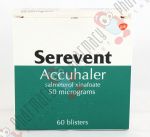People also ask
What is Serevent Accuhaler?
Serevent belongs to the group of medicines called bronchodilators. Serevent is indicated for regular long-term treatment of reversible airway obstruction caused by asthma and chronic bronchitis (COPD). In asthma, it will be co-administered in combination with long-term anti-inflammatory therapy with inhaled or oral glucocorticoids.
How does Serevent Accuhaler work?
The active ingredient of the Severent asthma inhalator is Salmeterol, which is a selective long-acting agonist of β2-adrenergic receptors. It inhibits the release in the lung of mediators from mast cells, thus inhibiting the response to the inhaled allergen and attenuating bronchial hyperreactivity.
What are the benefits of using Serevent Accuhaler?
The Severent asthma inhaler Indicated to prevent bronchospasm and reduce the frequency of acute exacerbations of asthma in patients with chronic asthma who are receiving anti-inflammatory therapy and still require regular treatment with an inhaled beta-adrenergic bronchodilator. Serevent® is a long-lasting beta-2 agonist and should be used only as a supplement to corticosteroids in the management of asthma. Patients should be advised not to discontinue or reduce therapy without medical advice, even if they experience any improvement with Serevent.
How do I use Serevent Accuhaler and its dosage?
Always use this medicine exactly as your doctor has told you. If in doubt, consult your doctor or pharmacist again.
Remember to use your medicine. IT IS VERY IMPORTANT THAT IT IS USED REGULARLY EVERY DAY. This will help keep you symptom-free throughout the day and night.
Your doctor will indicate the duration of your Serevent treatment. Do not stop treatment earlier, even if you feel better unless your doctor tells you to.
Serevent should only be used by inhalation and should not be used in children younger than 4 years.
If you have been prescribed Serevent for your asthma, you should continue to use any other medications you are taking to control your asthma. These should include an inhaled or compressed corticosteroid. Continue taking the same doses as before, unless your doctor tells you otherwise. Do this even if you feel better. Do not stop taking your inhaled (or tablet) corticosteroid when you start using Serevent.
It is very important that you follow your doctor's instructions on the number of times and how often you should use Serevent. Instructions for use are given below. If you have difficulties or do not understand the instructions ask your doctor or pharmacist.
The recommended dose is:
Adults
Two inhalations (50 micrograms) twice a day. If advised by your doctor, you can increase this dose up to four inhalations (100 micrograms) twice a day.
Use in children and adolescents
Children who are older than 4 years: two inhalations (50 micrograms) twice a day.
If you think that the action of Serevent is too strong or weak, tell your doctor or pharmacist.
Using the inhaler:
- Remove the mouthpiece guard, pressing gently on the sides.
- Check that there are no foreign particles inside and outside the inhaler, including the mouthpiece.
- Shake the inhaler well to ensure the removal of any foreign particles and that the contents of the inhaler are mixed properly.
- Hold the inhaler vertically between the index and thumb fingers, placing the thumb on the base, below the mouthpiece.
- Breathe in as much air as possible and then insert the mouthpiece into the mouth, between the teeth, closing the lips on the device, but without biting it.
- Immediately after you begin to breathe in through your mouth, press the top of the inhaler to release the medication and continue to take deep, steady breaths
- Hold your breath and take the inhaler out of your mouth, removing your finger from the top of the inhaler. Continue to hold your breath as long as possible.
- If another inhalation is to be administered, keep the inhaler upright and wait for approximately half a minute before repeating steps 3 to 7.
- Replace the mouthpiece guard by pushing firmly and tightening until you hear a click.
Using the accuhaler.
Sliding the lever of the device opens a small hole in the mouthpiece or mouthpiece and a ready-made dose is available for inhalation. When the device is closed, the lever automatically retracts to its original position, being ready for the next dose you need. The external case protects the device when not in use.
- Open: To open the device, grasp the outer casing with one hand and place the thumb of the other hand in the space reserved for it. Push your finger away from you as far as it will go.
- Slide: Keep the device with the mouthpiece towards you. Slide the lever away as far as it will go, you will hear a "click" sound. The device is ready for use. Each time the lever is pulled back, one dose is available for inhalation. This is shown by the dose counter. Do not manipulate the lever as there would be available doses that would be wasted.
- Inhale: Keep the device away from the mouth. Exhale (get the air out of the lungs) as reasonably possible (not inside the device).
- Place the mouthpiece on the lips. Breathe in (draw air into the lungs) progressively and intensely - through the device, not through the nose.
- Take the device out of your mouth.
- Hold your breath for about 10 seconds or as long as possible.
- Exhale slowly
- Close: To close the device, put your thumb in the hole reserved for it and slide it towards you, as far as it will go. When closing the device, you will hear a sharp click. The lever automatically returns to its original position and remains in place again. The device is now ready for reuse.
What are the Side effects & precautions of Serevent Accuhaler?
Like all medicines, this medicine can cause side effects, although not everybody gets them.
Some people may be allergic to medicines. If you experience any of the following symptoms shortly after using Serevent, STOP taking this medicine and notify your doctor immediately:
- The sudden appearance of whistles or tightness in the chest.
- Swelling of the eyelids, face or lips.
- Skin rash (hives) or hives anywhere on the body.
Some people, particularly those taking high doses of this type of medication, may occasionally feel a little agitated, have a headache, or notice that their heartbeats a little faster than normal, but these effects usually disappear with continued treatment. If this sensation continues, tell your doctor but do not stop the treatment unless he tells you to.
The side effects associated with salmeterol are listed below. Tell your doctor if you have any of the following symptoms:
Common side effects (may affect up to 1 in 10 people)
- Tremor and headache. They are characteristic of this type of medication and usually disappear over time. Tremor occurs more frequently if you receive doses greater than 50 micrograms, twice a day.
- Palpitations, which usually disappear over time.
- Muscle cramps.
Uncommon side effects (may affect up to 1 in 100 patients)
- Hypersensitivity reactions with a skin rash (Rash).
- Nervousness.
- Tachycardia (occurs more frequently if you receive doses greater than 50 micrograms, twice a day).
Rare side effects (may affect up to 1 in 1,000 patients)
- Hypokalemia (low levels of potassium in the blood).
- Insomnia
- Dizziness
Very rare side effects (may affect up to 1 in 10,000 patients)
- Hypersensitivity reactions including edema (swelling) and angioedema (skin reaction with redness, swelling, itching, and difficulty breathing), bronchospasm (a contraction of the bronchi causing difficulty in breathing), and anaphylactic shock (severe allergic reaction).
- Hyperglycemia (elevated blood glucose levels). If you have diabetes, you may need to monitor your blood sugar levels more frequently, and you may need to adjust your diabetes treatment.
- Cardiac arrhythmias, including atrial fibrillation, supraventricular tachycardia, and extrasystoles (heart rhythm disorders).
- Throat or pharynx irritation, paradoxical bronchospasm (narrowing of the bronchial walls with decreased air intake and difficulty breathing).
- Nausea
- Arthralgia (joint pain)
- Nonspecific chest pain.
How to Buy Serevent Accuhaler online in the UK?
You can buy Serevent Inhaler online through one of the UK’s leading online pharmacies, Pharmacy Planet. It's easy and convenient. You will need to fill out a short assessment and the item will be delivered directly to your door. If you want to buy this asthma medication online, use Pharmacy Planet, a UK pharmacy you can trust.














